Sellfy review 2024: Is It the Right Ecommerce Platform For You?
Sellfy Review 2024: Is It The Easiest Way To Sell Online?
Welcome to my comprehensive Sellfy Review for 2024. As an entrepreneur and avid user of various e-commerce platforms, I’ve taken a deep dive into Sellfy to bring you an in-depth analysis of its features, usability, and overall value for online businesses. In this ever-evolving digital marketplace, finding the right ecommerce solution to sell your products can be a game-changer for your business. Through my personal lens, I’ll explore whether Sellfy stands up to the demands of modern e-commerce and if it could be the key to unlocking your online success.
Whether you’re a seasoned online seller or just starting, understanding what Sellfy offers is essential in making an informed decision for your e-commerce strategy. Let’s explore the capabilities of Sellfy and see how it stacks up in the competitive world of online sales platforms.
Key Takeaways:
What is Sellfy?
Sellfy is an e-commerce platform designed to simplify the process of selling products online for creators. Sellfy lets users sell various items, including physical and digital products, subscriptions, and print-on-demand merchandise from their online store. The platform is known for being user-friendly and efficient, making it ideal for creators and online businesses who prefer a straightforward approach to e-commerce without the technical complexities.
Sellfy also offers features like built-in marketing tools to help grow sales and the ability to reach audiences directly on social media or any other platform with a custom storefront.
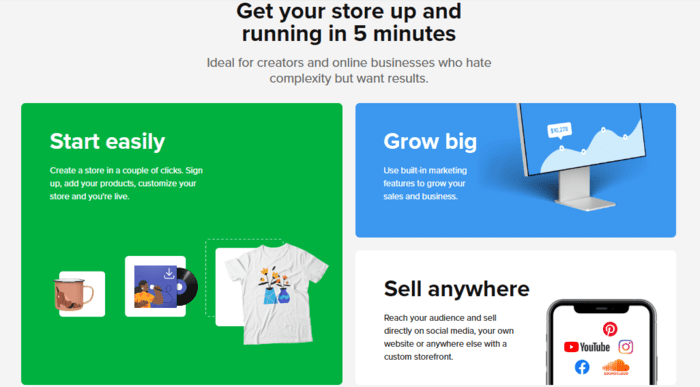

Sellfy Features: Sellfy Review
Products:
The Sellfy platform allows store owners to categorize their products efficiently. This feature makes your store more user-friendly for customers who want to buy something, enabling them to navigate through your products more smoothly, regardless of how many or what kind of products you have.
Here’s how it works:
- Creating Categories: You can create categories to organize your products any way you like. To add a category, go to Store Settings > Product Categories, click ‘Add new,’ enter the Title and slug, and then click ‘Save.’ You can also create a new category while adding a product through the Product editor.
- Editing Categories: Modifying and removing categories is straightforward. You can delete or hide a category by turning off the toggle switch in the Store Settings. This flexibility allows you to tailor your store’s navigation to your business needs.
- Categorizing Products: You can add products, remove from, or even exclude from categories. This helps organize your store’s layout and helps customers view only the products within the selected category.
- Store Customizer: Some category settings and visual aspects can be adjusted in the Store Customizer. For example, to make product categories visible on your store menu, you would navigate to the Product module in the Store settings and turn the toggle switch for ‘Show product categories.’
Sellfy’s product section is designed to enhance the shopping experience for the store owner and the customers, making it a valuable component of the Sellfy e-commerce platform.
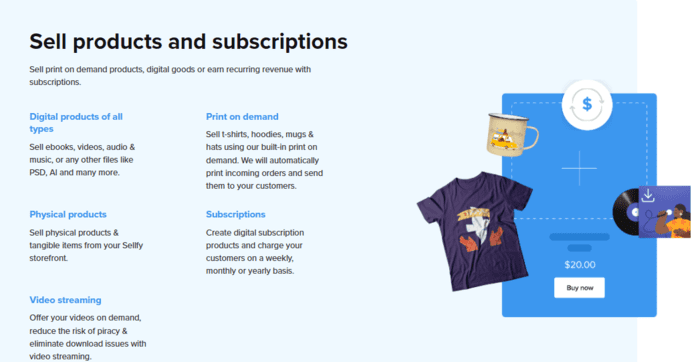

Orders:
The Orders section in Sellfy is a crucial feature for managing and tracking all transactions in your store. It provides a comprehensive sales overview, allowing you to monitor and handle orders effectively. Here’s what you can do with the Orders section:
- Search Orders: You can search for specific orders using the customer’s email, which is helpful when quickly finding a transaction or addressing a customer’s inquiry.
- Search Orders: You can search for specific orders using the customer’s email, which is helpful when quickly finding a transaction or addressing a customer’s inquiry.
- Order Management: Once you locate an order, you have several options. You can view the order details, update the status, and even add a tracking URL for shipped items. This is particularly useful for physical products, as it helps you and your customers keep track of the delivery process.
- Mark as Shipped: You can mark orders as shipped for physical products. This updates the order status and notifies the customer that their item is on its way. You can also paste the tracking URL to give customers real-time updates on their shipments.
- Order Details: The order details page is where you can see all the relevant information about a purchase, including the product purchased, the payment method used, and the customer’s contact information. This helps you maintain records and provide personalized customer service.
The Orders section is designed to streamline the post-purchase process, ensuring sellers and buyers have a smooth and transparent experience.
Built-in marketing:
Sellfy’s built-in marketing features help you market your products effectively and quickly grow your business. Here are some of the vital marketing tools that Sellfy offers:
- Discount Codes: Engage with customers and increase sales by creating discount codes. This feature allows you to run promotions, offer special deals, and incentivize purchases.
- Email Marketing: You can communicate with current customers and acquire newsletter followers directly through your store. You can send your audience product updates, announcements, and other important information.
- Upselling: Provide powerful upsell options to customers during checkout to increase your average order value. This tactic encourages customers to purchase additional products or upgrade their current selection.
- Tracking Pixels: Add Facebook and Twitter ad pixels to create targeted ads for your store and track their performance. This helps you understand the effectiveness of your advertising campaigns and optimize them for better results.
- Embed Options: Sellfy allows you to embed “Buy now” buttons, product links, and product cards on your website or blog, making it easy to monetize your existing content and reach customers in various online spaces. I will discuss this in detail in the following sections.
- YouTube End Screens & Cards: Drive more traffic to your store using Sellfy on YouTube cards and end screens. This integration helps you leverage your YouTube audience and convert viewers into customers.
These marketing tools are part of Sellfy’s comprehensive approach to e-commerce, enabling you to sell your products, effectively promote them, and build a loyal customer base.
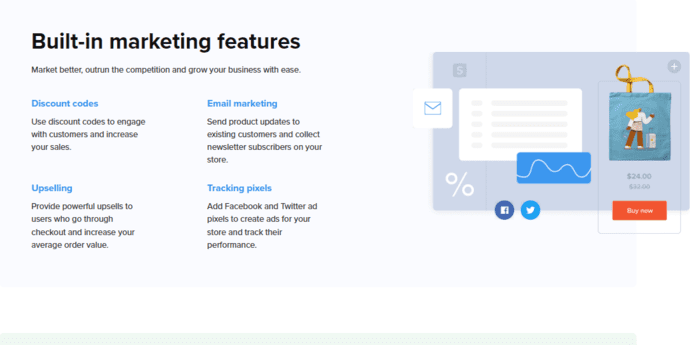

Website Embed:
Sellfy’s website embed feature is a powerful tool that allows you to embed your store directly into your website or blog. This feature is helpful for creators and businesses that already have an established online presence and want to add e-commerce functionality without needing a separate storefront. Here’s how the website embed feature works:
- Embed Options: Sellfy provides various embed options, including adding a ‘Buy now’ button, a single product, or all products to your website. You can also embed a product category if you want to showcase a specific line of products.
- Customization: The embed options are customizable, allowing you to match the look and feel of your website. You can tailor the ‘Buy now’ buttons and product displays to align with your site’s design.
- Embedded Checkout: When customers click the ‘Buy now’ button on your site, the checkout process starts in a pop-up modal window, keeping them on your website throughout the transaction. This seamless experience can help reduce cart abandonment rates.
- Shopping Cart Feature: If customers can add multiple items to their cart before checking out, pair the ‘Buy now’ button or product embed with the shopping cart feature. This adds even more functionality to your website’s shopping experience.
- Cross-Domain Measurement: Using the embed method, you can enable the cross-domain measurement function to track statistics with Google Analytics. This helps you gain insights into your customers’ behavior and your store’s performance.
The website embed feature of Sellfy provides a flexible and efficient way to sell products directly from your website, enhancing the user experience and potentially increasing sales. You can embed the entire Sellfy store in your existing site. Whether using WordPress, Squarespace, or another platform, Sellfy’s embed feature can be a valuable addition to your online business strategy.
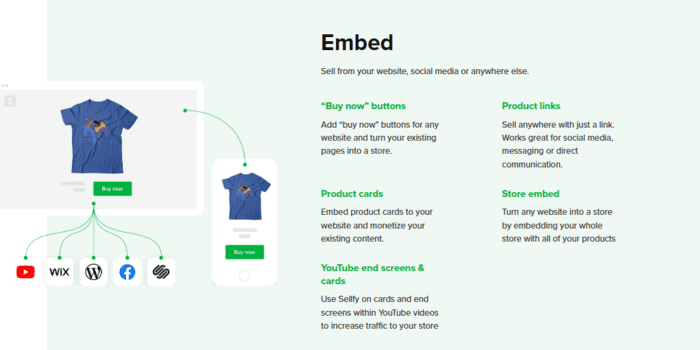

Analytics:
Sellfy’s analytics capabilities give store owners valuable insights into their business performance, helping them make informed decisions to grow their sales. Here’s an overview of the analytics features available on Sellfy:
- Visits Tracking: Sellfy tracks store visits, counting product page and store page visits as unique visits. It does not track product views as separate visits, ensuring each visitor is registered as a single visit.
- Purchases Data: The platform displays the number of placed orders within a certain period. If a customer purchases multiple products in a single transaction, it is shown as one purchase.
- Conversion Rates: Sellfy calculates the percentage of store visits that result in actual purchases, providing insight into the effectiveness of your store’s layout and offerings.
- Revenue Statistics: The revenue section shows the total revenue generated during a specified period, including tax and transaction fees. Store analytics can be viewed in different currencies by changing the primary account currency in the Sellfy account settings.
- Top Products: This section is sorted by revenue and shows which products have been most successful in your store, allowing you to identify bestsellers and adjust your strategy accordingly.
- Traffic Sources: Sellfy offers a list of traffic sources based on different referral channels such as direct, social, search, or others. This helps you understand where your customers come from and how they find your store.
- Customer Geography: The countries section displays where your store visitors are purchasing from, which can be useful for targeting marketing efforts and understanding your global reach.
Additionally, Sellfy allows integration with Google Analytics for even more in-depth data analysis. By linking Google Analytics to your Sellfy account, you can gain insight into website traffic and visitors’ behavior, measure the success of marketing campaigns, and collect enhanced e-commerce data.
You can see how well your store is performing, track your sales, and know your customers’ needs from the Sellfy analytics dashboard. Based on these data, you can adjust your marketing and product tactics for better outcomes.
Customer:
Sellfy offers a range of features designed to help sellers manage their customers effectively. Here’s an overview of the customer section feature of Sellfy:
- Customer Management: Sellers can view and manage their customer list, track customer activity, and access order history.
- Discount Codes: Sellers can create discount codes to offer special deals to their customers, which can be a great way to increase sales and reward loyal customers.
- Shopping Cart: The feature enables customers to purchase multiple items simultaneously, providing a seamless shopping experience.
- Store Language: Sellfy’s storefront can automatically translate to the customer’s language based on their location, making it more accessible to a global audience.
- PDF Stamping: To protect digital content, Sellfy can automatically add buyers’ email addresses to every page of a PDF product file, giving each customer a uniquely marked file.
These features are part of Sellfy’s comprehensive suite of tools designed to help sellers create, market, and sell their products from one platform.
Store Settings:
The Store Settings feature of Sellfy is vital for sellers to customize and manage their online ecommerce store. Here’s an overview of what you can do with Sellfy’s Store Settings:
- Edit Store Details: You can edit your store name and URL, connect a custom domain, and change your store language to suit your brand and target audience better.
- Customize Store Appearance: The Store Customizer allows you to design a store that aligns with your brand identity. You can edit elements like the store name, logo, browser tab icon (favicon), shopping cart, and store search options. I will elaborate more on customization in the following sections.
- Manage Visibility: Options to hide the “Powered by Sellfy” logo (available for Business and Premium plans) and enable or disable breadcrumbs are available to streamline the customer experience.
- Implement Custom Code: For those who need more customization, there’s the ability to add custom code to your store, which is activated once you upgrade to a paid plan.
These settings are part of Sellfy’s suite of tools that empower sellers to create a personalized and professional online store.
Customization:
Sellfy provides robust customization capabilities to help you create a unique and branded online store. Here’s what you can do with Sellfy’s customization options:
- Store Customizer: This tool lets you design your store to best fit your brand and products. You can navigate between pages, add content, and customize store elements.
- General Settings: Edit basic elements like the store name & logo, browser tab icon (favicon), shopping cart, store search, and more. Business and Premium plans can hide the “Powered by Sellfy” logo and enable/disable breadcrumbs.
- Custom Code: Add a custom code to your store for further personalization, activated once you upgrade to a paid plan.
- Store Style: Customize store-wide elements such as themes, page background, Buy Now button color, text color, and fonts.
- Modules: Customize modules like the Hero block, Text panel, Newsletter form, Products, Contact form, and Embed module to enhance the functionality and appearance of your store.
- Custom Pages: Create and customize pages to suit your needs, whether a landing page, a banner, or using custom code for more complex designs.
These tools allow you to create a store representing your brand and appealing to potential customers.
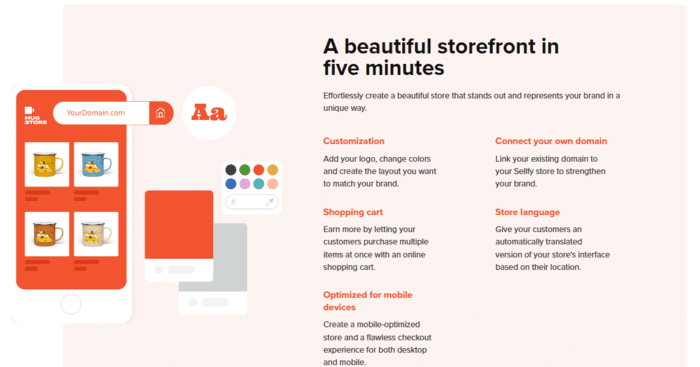

Integrations:
With Sellfy’s integration feature, you can enhance your online store’s functionality and improve your e-commerce operations by connecting it with various services and apps.
Here’s an overview of what you can do with Sellfy’s integration feature:
- Google Analytics: Set up Google Analytics with your Sellfy store to track and analyze your store’s traffic and customer behavior.
- Webhooks: Use webhooks to get real-time notifications about specific events in your store, such as new orders or product updates.
- Facebook Live Chat Integration: Add Facebook Live Chat to your store to communicate with your customers in real-time and provide better customer support.
- Patreon Integration: Connect your store with Patreon to offer exclusive products or discounts to your patrons.
- Zapier: Integrate with Zapier to connect Sellfy with thousands of other apps and automate workflows.
- Facebook Ads Integration: Set up Facebook Pixel with Sellfy to create targeted ads for your store and track their performance.
- Twitter Ads: Use Twitter ads to promote your products and reach a wider audience.
- Google Merchant Center: Connect your Sellfy store with Google Merchant Center to list your products on Google and reach more customers through Google Search, YouTube, Google Assistant, and Google Maps.
These integrations are designed to help you reach more customers, increase store traffic, and gain valuable insights into customer trends and behavior.
Pro Tip:
Pabbly Connect is an excellent option to consider if you’re looking for an affordable integration program. It offers a lifetime deal that allows you to use the software without any monthly subscription fees. Pabbly Connect is the most affordable Zapier alternative. Delve into this comprehensive Pabbly Connect review here.
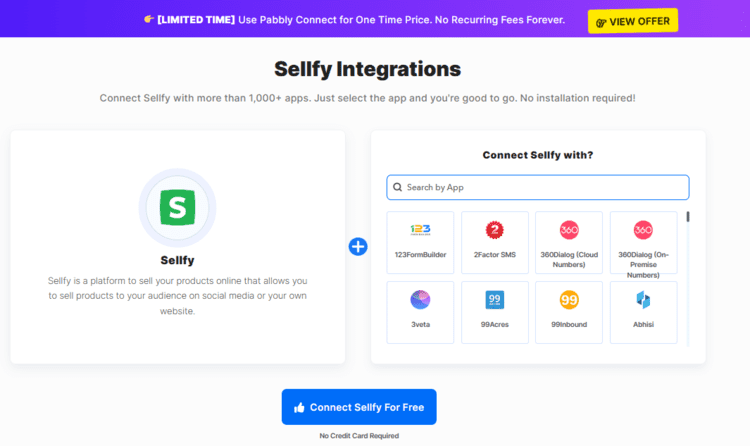

Secure Payments:
Sellfy takes the security of payments on its platform very seriously. Here’s how Sellfy ensures the security of transactions:
- PCI-DSS Compliance: Sellfy is ready for PCI-DSS, which stands for the Payment Card Industry Data Security Standard, a set of security standards that require all companies that work with credit card information, whether they accept, process, store, or transmit it, to keep a secure environment.
- Trusted Payment Processors: Sellfy uses trusted payment processors to handle buyers’ payment information. This means that established and secure services like PayPal and Stripe manage the payment details.
- Immediate Payment Transfer: Payments made through Sellfy are immediately transferred to the seller’s Stripe or PayPal account, ensuring no delay in the transaction process. Users will shoulder the payment processing fees of Stripe and PayPal since these are not part of the Sellfy cost.
- Fraud Prevention: Sellfy has an automatic IP-based security system to help prevent fraudulent transactions. This system recognizes and blocks IP addresses testing different credit cards through your checkout.
These measures are in place to protect both the sellers and the customers, ensuring that the payment process is secure and reliable.
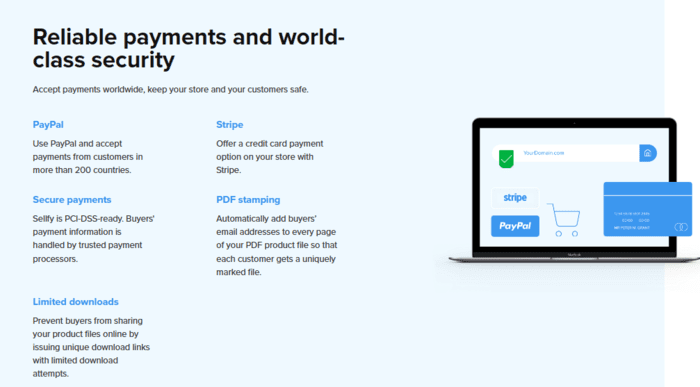

Ease of Use:
Sellfy is praised for its ease of use, making it a user-friendly platform for sellers. Here are some key points highlighting the ease of use of Sellfy:
- Quick Setup: Sellfy’s platform is designed to be straightforward, allowing you to build an online store in under five minutes. The setup process is simple, with only a few steps to get your store up and running.
- Intuitive Interface: Users can easily navigate and manage their stores with the platform’s intuitive interface, which does not require much learning.
- Limited platform customization: While some might see this as a limitation, the limited customization options contribute to the platform’s simplicity, making it less overwhelming for new users.
- Digital Product Focus: Sellfy is well-suited for selling digital platforms, simplifying the process for creatives like designers, filmmakers, writers, musicians, painters, and artists.
Sellfy is considered one of the easiest and simplest tools for quickly setting up an online store, especially if you’re focused on selling digital products. It’s an excellent choice for those who want to avoid the complexity and higher costs, as you agreed with more advanced platforms.
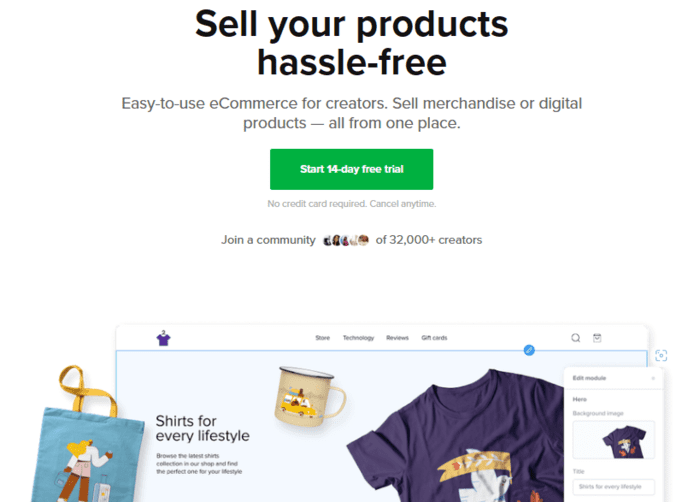

Who Uses Sellfy?
A diverse group of online sellers and creators uses Sellfy. According to the data, Sellfy’s audience is predominantly male (65%), and the largest age group of visitors is 25 – 34 year olds. This demographic suggests that it is popular among young entrepreneurs and creators who are digitally savvy and likely involved in selling digital products, subscriptions, print-on-demand products, or other physical products online. The platform is designed to cater to independent creators and small businesses who value simplicity and ease of use in an e-commerce solution.


Customer support:
If users encounter questions or problems while using the platform, they can get assistance from Sellfy’s customer support.
Here’s what you can expect from Sellfy’s customer support:
- Help Center: Users can find articles on various topics, from how to get started and set up their account to how to customize their store and collect payments, in Sellfy’s extensive Help Center.
- 24/7 Support: Sellfy provides around-the-clock support to help you whenever needed. You can get assistance regardless of your time zone or working hours.
- Contact Options: Sellfy offers contact options through email for direct assistance. This allows you to reach out to their support team for personalized help.
- Community: Sellfy has a community of creators where you can share experiences, ask for advice, and learn from others using the platform.
Sellfy’s customer support is geared towards providing a helpful and responsive service to ensure users can effectively manage their online stores and resolve issues promptly. Whether you’re just starting or an experienced seller, Sellfy’s customer support is there to back you up.
Sellfy Pricing Plan:
Sellfy offers three main pricing plans to cater to different levels of sales volume and features required by sellers. Here’s a summary of the plans:
Starter Plan:
Priced at $ 19 per month when billed every two years or $29 when billed monthly. This plan suits sellers with up to $10k in sales per year. It includes unlimited products, digital products, subscription products, and email marketing with 2,000 credits.
Business Plan:
Priced at $49 per month when billed every two years or $79 per month when billed monthly. This plan is designed for sellers with up to $50k in sales annually. It offers everything in the Starter plan, plus product upselling, cart abandonment, affiliate marketing, and the ability to remove “Sellfy” branding.
Premium Plan:
Priced at $99 per month when billed every two years or $159 per month when billed monthly. This Sellfy plan is for sellers with up to $200k in annual sales. It includes everything in the Business plan, plus product migration and priority support. You can also migrate the entire store design of your existing site to the Sellfy platform.
All plans come with a 14-day free trial and include features like a store editor, store themes, the ability to apply custom code, connect your domain, and more. There are no transaction fees on any of the plans.
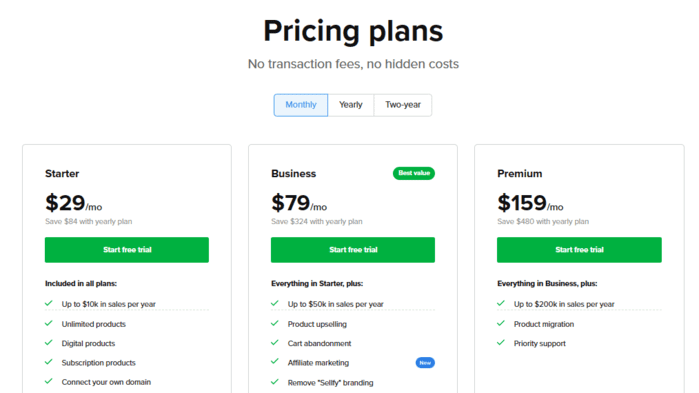

Sellfy Pros And Cons:
Pros:
Cons:
Sellfy User Reviews1:
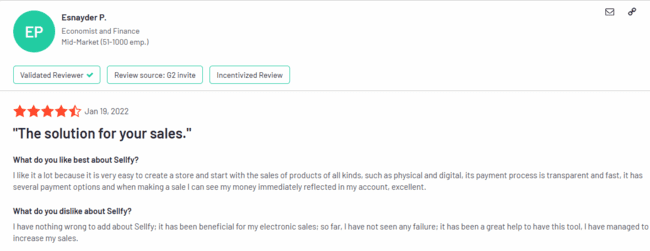

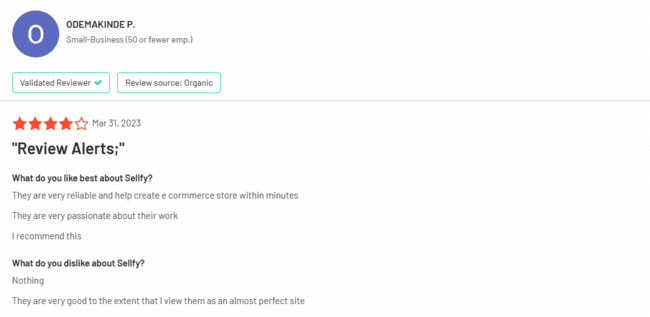





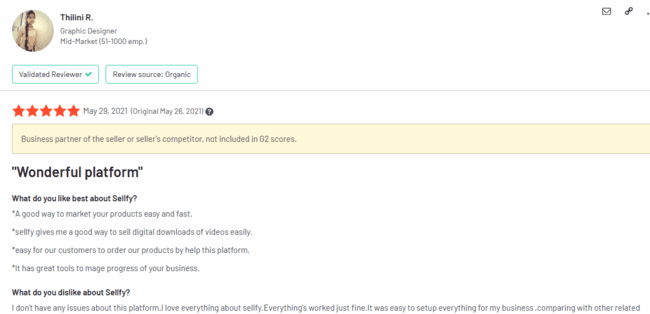

Alternatives to Sellfy:
Etsy:
Etsy is an online marketplace that connects people from all over the world who want to make, sell, buy, or collect unique items. It’s known for its focus on handmade or vintage items and craft supplies. Sellers can set up their storefronts within the Etsy ecosystem, and the platform offers various tools for promotion and analytics.
Sellfy is a platform that caters to creators who want to sell digital products online, offering features like email marketing and a VAT MOSS system. Etsy, on the other hand, is a marketplace where people can find handmade or vintage items and craft supplies.
Etsy has a built-in audience and an established payment system, but sellers may face more competition and have less control over their branding.
WooCommerce:
WooCommerce is a customizable, open-source eCommerce platform built on WordPress. It allows you to sell anywhere, from real products and digital downloads to subscriptions and content. It’s highly extendable with thousands of plugins and themes and can scale to meet the demands of both small and large online stores.
WooCommerce is an open-source e-commerce toolkit for WordPress, offering high customizability and scalability, especially for users already familiar with WordPress. In contrast, Sellfy provides a more straightforward, user-friendly platform with built-in marketing tools and no need for paid add-ons.
Shopify Ecommerce Platform:
Shopify is a cloud-based commerce platform that is a leader in its field and caters to small and medium-sized businesses. It offers many features, including an online storefront, payment processing, marketing tools, mobile apps, and more. Shopify is known for its ease of use and ability to scale with your business.
Shopify is a well-known e-commerce platform with a wide range of features and an extensive app market, suitable for businesses of all sizes. Like Shopify, Sellfy is a cloud-based program but is a simpler alternative focusing on digital and print-on-demand products, offering a more streamlined setup and ease of use.
Ecwid:
Ecwid is an eCommerce platform that allows you to easily create an online store and sell across multiple channels, including websites, social media, and marketplaces. It offers features like a mobile-responsive shopping cart, automated shipping and tax calculations, and integration with various payment gateways.
Ecwid allows you to add a shopping cart to an existing website and offers a complete e-commerce solution with features like multichannel selling and inventory management. Sellfy is more focused on creators and provides a platform that’s easy to use with marketing tools built-in.
SamCart:
SamCart is an eCommerce platform that optimizes the checkout experience to maximize conversion rates. It offers pre-made templates, A/B testing, flexible payment options, one-click upsells, and integration with various marketing tools. SamCart is designed to help creators and entrepreneurs sell products and services online.
SamCart is a web-based checkout platform that emphasizes optimizing the checkout experience. Sellfy, while also providing a smooth checkout process, offers an entire storefront where you can host all your products, making it a more comprehensive solution for sellers. Explore the comprehensive Samcart review here.
Systeme.io:
Systeme.io is also an alternative to Sellfy. Both platforms offer entrepreneurs and business owners tools to sell their products and services online. Systeme.io is a comprehensive marketing platform with features like sales funnels, email marketing, a blog builder, an affiliate program, and membership sites. It’s designed as an all-in-one solution for managing and growing an online business.
Sellfy, on the other hand, is more focused on creators selling physical products, digital products, subscriptions, and print-on-demand goods. It offers an easy-to-use platform with features like a store editor and built-in marketing tools. It’s the ability to sell directly through social media and other websites.
While both platforms serve the e-commerce market, they cater to slightly different audiences and needs. Systeme.io’s broader range of marketing tools may suit users looking for an all-encompassing business solution. In contrast, Sellfy’s simplicity and focus on digital goods might appeal more to independent creators and small businesses. Read the complete Systeme.io review here.
Final Thoughts:
After thoroughly exploring Sellfy’s various features in this Sellfy review, I believe it stands out as a strong contender in the e-commerce platform market, especially for creators and small businesses looking to sell digital products, subscriptions, and print-on-demand goods. Its ease of use, straightforward setup, and built-in marketing tools make it an attractive option for those wanting to get their store up and running quickly without extensive technical knowledge.
Sellfy’s pricing plans are reasonable, offering different tiers to accommodate varying sales volumes and feature needs. The platform’s customer support and community are valuable resources for any seller. While it may have a limited customization option or the broad third-party app marketplace of some of Sellfy’s competitors, its simplicity and focus on digital goods might be precisely what you’re looking for.
Recommendations:
As someone who values a user-friendly experience and is looking for a platform that simplifies the online selling process, I find Sellfy a compelling choice. Whether you’re an artist, a writer, a musician, or a small business owner, Sellfy provides the essential tools to help you with your products and grow your brand online. If these qualities align with your needs, then Sellfy is a great option for your e-commerce platform.


Sellfy
Discover Sellfy, the user-friendly platform designed specifically for selling digital products. With its fast load times and a fully customizable personal storefront, Sellfy offers an unparalleled e-commerce experience. Don’t miss out, start your 14-day free trial today and see how Sellfy can transform your digital sales journey!
If you’re seeking more than just an e-commerce platform and require a cost-effective solution for sophisticated sales funnel creation and email marketing, consider exploring Systeme.io. This platform serves as a comprehensive marketing tool and even offers a perpetual free plan.


Systeme.io
Systeme.io is the best option for Businesses looking for an affordable All-In-One Business Platform. It gives you everything you need to create sales funnels, webinars, email campaigns, online courses, landing pages, blogs, and more. And it’s incredibly affordable – you can get started for free and pay as you grow. Don’t miss this opportunity – sign up for the Free Version Forever Plan now.
Frequently Asked Questions
Is Sellfy a reliable site?
Yes, Sellfy is a reliable site. Sellfy is an ecommerce platform that allows creators to sell digital products such as ebooks, music, videos, and software directly to their audience. It has been around since 2011 and has served over 100,000 creators worldwide.
How much does Sellfy take?
Sellfy does not take any percentage of the revenue generated from sales. Creators keep 100% of the revenue generated from sales.
How do I promote my Sellfy store?
1) Share your products on social media platforms such as Facebook, Twitter, and Instagram. 2) Use Sellfy’s built-in email marketing tool to send promotional emails to your subscribers. 3) Offer discount codes to your customers. 4) Collaborate with other creators or influencers in your niche. 5) Consider using paid advertising such as Google Ads or Facebook Ads.
Can you make money on Sellfy?
Yes, you can make money on Sellfy. Creators can set the prices for their digital products and keep 100% of the revenue generated from sales. Sellfy does not charge any transaction fees or commissions on sales.
Can I use Sellfy for free?
Sellfy offers a free 14-day trial for new users. After the trial period, users can choose from three pricing plans: Starter, Business, and Premium. The Starter plan is free and allows creators to sell up to 10 products.
Is Sellfy a good platform?
Sellfy is a good platform for creators who want to sell digital products directly to their audience. It offers a user-friendly interface, customizable storefronts, and a range of features such as discount codes, email marketing, and analytics. Sellfy also provides integrations with other services, such as PayPal and Stripe, for payment processing.










Thanx for the effort, keep up the good work Great work, I am going to start a small Blog Engine course work using your site I hope you enjoy blogging with the popular BlogEngine.net.Thethoughts you express are really awesome. Hope you will right some more posts.
I’ve recently started a site, the info you provide on this site has helped me greatly. Thank you for all of your time & work.
I’ve read some good stuff here. Certainly worth bookmarking for revisiting. I surprise how much effort you put to make such a great informative website.
Thanks.
Great website. Lots of useful information here. I¦m sending it to several friends ans also sharing in delicious. And obviously, thanks to your effort!
Thanks for appreciating our efforts.